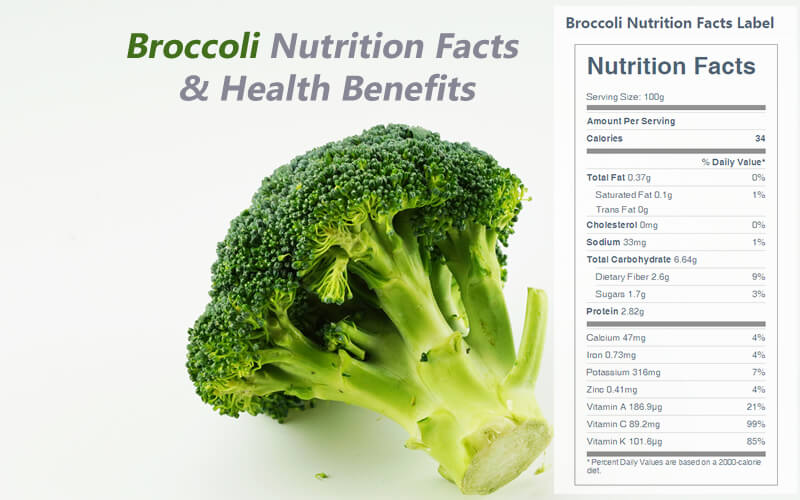Broccoli Nutrition Facts & Health Benefits
Broccoli is a cruciferous plant with cancer-protective properties. Broccoli microgreens have been found to play an important role in reducing the risk of chronic disease.
Broccoli is an excellent source of fiber, folate, and vitamins C and K. It's a very good source of potassium, B2, and B6 and contains reasonable amounts of iron, calcium, and vitamin E.
The nutritional value of broccoli
Raw broccoli is 89% water, 7% carbohydrates, 3% protein, and contains negligible fat. A 100-gram reference serving of raw broccoli provides 34 calories and is a rich source of vitamin C and vitamin K. Raw broccoli also contains moderate amounts of several B vitamins and the dietary mineral manganese, whereas other micronutrients are low in content.
One cup of chopped raw broccoli provides 24 calories, 4.6 g carbohydrate, 2.6 g protein, 0.4 g fat, 2.6 g dietary fiber, 1356 IU vitamin A, 82 mg vitamin C, 62 mcg folic acid, 286 mg potassium, 58 mg phosphorus, 24 mg sodium, 42 mg calcium, and 22 mg magnesium.

Broccoli Nutrition Facts Label
Health Benefits of Broccoli
Cruciferous vegetables also suppress free-radical formation, making them good for joints and the heart.
Broccoli helps to destroy damaged cells, helps prostate cancer, prevents cataracts, and builds stronger bones.
Broccoli carries all the same benefits as its brother vegetable brussels sprouts. Six major population studies analyzed at the US National Cancer Institute showed that the more cruciferous vegetables (including cauliflower, radishes, horseradish, cabbage, spring greens, turnips, Brussels sprouts, and kale) you eat, the lower your chances of developing colon cancer—a finding now reinforced by the American Institute of Cancer Research.
Broccoli delivers a significantly higher amount of sulforaphane than any other Brassica vegetable.
Sulforaphane is important because it serves as a potent antioxidant and supports our livers’ detoxification system. It gets released when broccoli is cut, chopped, or chewed, which is fascinating because sulforaphane is part of the plant's defense system. So, when broccoli is being attacked by a bug, for instance, the key enzyme myrosinase is released and activates glucoraphanin into sulforaphane. These enzymes get released when damage is done to the plant. This same mechanism kicks into gear when we cut and chop the plant as well.
Additionally, broccoli has high amounts of indole-3-carbinol. In the upper GI tract under acidic conditions, it works to activate a receptor in the gut that maintains immune cells in the intestinal tract. These cells act like soldiers that line the intestinal tract—and they house additional immune cells as backup!
Eating broccoli raw gives you the highest amount of sulforaphane and its great antioxidant properties, roughly ten times more than when it is cooked. Lightly steaming broccoli for three minutes helps release this compound, the key takeaway is not to overcook! Contents of its characteristic sulfur-containing glucosinolate compounds, isothiocyanates and sulforaphane, are diminished by boiling but are better preserved by steaming, microwaving or stir-frying.